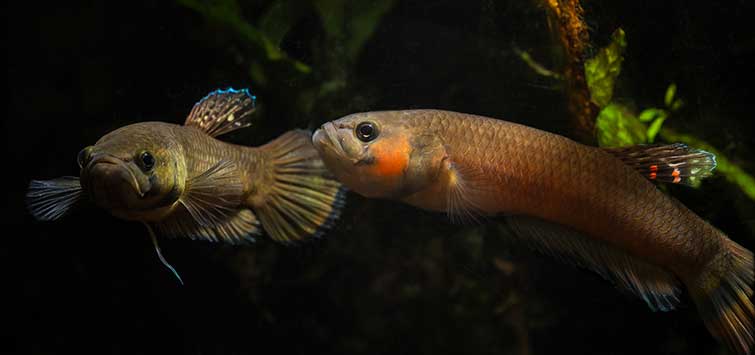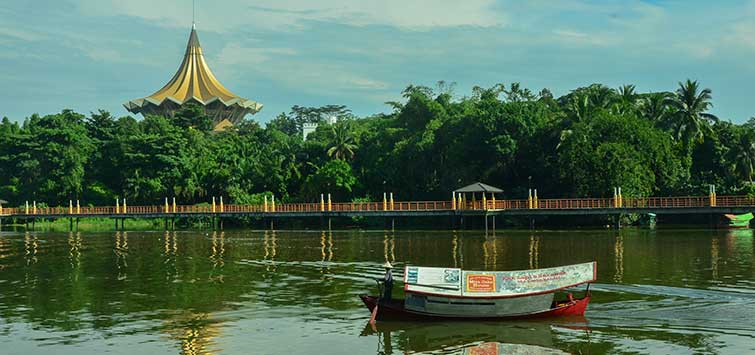A Quest for Goodeids in Mexico: Searching for the Black Prince Characodon audax (Smith & Miller 1986)
Author: Uwe Dost
The author recalls his exciting trip south of the border searching high and low for endangered goodeids, including the elusive Characodon audax.
A Shortage of Goodeids
I have been keeping livebearers in my tanks for many years, during which I have made several trips to the native lands of my fish to observe and catch them in their natural habitat. In recent years I’ve been reading a lot about the decline in wild goodeid populations and that many are threatened with extinction, so I decided to make a trip to Mexico in search of native goodeids.
In May 2000 my friend Walter Kroll and I traveled through the Mexican Altiplano (the high plateau between northern Mexico’s Sierra Madre Occidental and Sierra Madre Oriental mountain ranges), searching especially for goodeids. Before this trip my main interest lay with the better-known livebearers of the family Poeciliidae like swordtails, guppies, and platies. In fact, I’d only kept only a few species of goodeids. One reason was that they are seldom found in petshop tanks, but another is they are generally regarded as aggressive and not very colorful. However, many of the goodeids we caught on our trip were very colorful, so I found myself regretting that I didn’t get interested in them before.
Endangered and Extinct Species
There are only three species in the genus Characodon. One of them, C. garmani Jordan & Evermann 1898, the Parras goodeid, is extinct. The two other species are very attractive fishes, but they are in danger. The rainbow goodeid C. lateralis GÜnther 1866 is endangered, and the “black prince” or bold goodeid C. audax Smith and Miller 1986 is listed as vulnerable. The latter is especially at risk because it is known only from a single location. The rainbow goodeid had a wider range, but recently many populations have died out.
The Search Begins
The starting point of our quest was Mexico City, and from there we drove west in the general direction of Puerto Vallarta. We visited some goodeid habitats on our way to the west coast, but then we drove north from Puerto Vallarta into the area around the town of Durango. This is the natural range for goodeids of the genus Characodon. Their range is distinctly separate from the ranges of other members of the family Goodeidae in the plateau of central Mexico.
There are several reasons for the extinction of many native fish species in the Mexican Altiplano. Except for the increasing drought in the last few years, all the reasons are of human origin. For example, most Mexican people live and work on this dry plateau. In fact, Mexico City is the only capital in the world that is not located on a river. The demand for water for domestic, agricultural, and industrial uses is rapidly exhausting local springs and aquifers. In addition to desertification from this water loss, many habitats are destroyed by environmental pollution and by the introduction of alien fish species, such as tilapia, into the few remaining year-round water sources in the area. These invaders eliminate most of the native species in a short period of time.
On to Durango
Durango is a big city at the edge of the Sierra Madre Occidental, nearly 1900 m (6100 feet) above sea level. This town is famous for its Wild West character and the rugged landscape surrounding it, which has made it a favorite spot for filming westerns. We started out after an early breakfast for the village of El Toboso, the location of C. audax. Unfortunately, the friendly gas station attendant we asked for directions eagerly sent us in the wrong direction, but an old man in the village where we wound up knew the area much better and set us straight, so with only a slight delay we headed for El Toboso.
The First Catch
Our first stop was a small meter-wide ditch running along the street in the hamlet Abraham Gonzalez. A Dutch friend of mine, Brian Kabbes, had caught only Gambusia senilis here just six months before our visit, so we didn’t expect much. To our surprise and delight, however, we spotted a large goodeid struggling in the net with several Gambusia. We tried desperately to find more, but all of our casts only produced one more specimen. At first I thought it was a large old female G. lateralis, but later on when we caught some G. lateralis we could see that these two fish were different in shape and coloration. To this day we still are not sure whether the large (about 5 cm) Abraham Gonzalez fish are a new Characodon species or just a variant population of G. lateralis.
The parameters at the collecting site at 11 a.m. were: air temperature 30°C (86°F), pH 7, hardness 8 degrees, carbonate hardness 7 degrees, water temperature 23°C (73°F). The ditch was about 50 cm (20 inches) deep, and the banks were lined with a profusion of plants and algae, and the fish dove into this dense growth when we tried to catch them. The bottom was covered with debris, but the water was clear. There were also many aquatic insects, big tadpoles, and green frogs.
After some time we decide to look for the source of the water in the ditch to find perhaps more goodeids. At the edge of the village we found the stream had been dammed to form a pond that the local people used for washing. There was an astonishingly green oasis around this pond compared to the dusty dry landscape elsewhere. There were mud turtles basking on stones at the edge of the pond that jumped into the water at our approach. The pond was about 1.5 m (5 feet) deep, but it was a bit muddy and we could not see the bottom. We did see some introduced tilapia and a lot of Gambusia. We did not know if these were artificially introduced or arrived naturally, but on our trip we often found native Mexican fish like swordtails Xiphophorus far from their natural ranges, so it is not only exotic species from other continents that take over habitats and eliminate the original local species.
The pond was fed from a swampy meadow, where we saw many Gambusia, so we didn’t search much beyond the pond, though we did see some large areas of open water. After returning home I regretted that we didn’t check them for goodeids. In any case, we headed for our major destination—the spring Ojo de Agua de las Mujeres, the only known collecting site for C. audax.
El Toboso
From Abraham Gonzalez a small dusty gravel path leads through a rough, cactus-filled wilderness. The landscape here is of volcanic origin, looking a bit like another planet. Lava rocks cover the ground everywhere, and the area is known for its venomous scorpions. We couldn’t see any signs of human presence and labored on in the afternoon sun with the temperature about 35°C (96°F). Finally we crested a low hill and saw some huts below—El Toboso!
In front of the village is a depression we recognized from our research. It was enclosed by a fence and used as a pasture for cattle. During the rainy season a pond forms there. Since there is no outlet, no fish can immigrate into the springs of El Toboso. We were there during the dry season at the end of May, but we could easily visualize the shape of the pond because the lack of vegetation revealed where it would be. We expected to find a residual pond further down the hill. My Dutch friend had caught C. audax in this pond back in December, but we found no water at all.
But he had told me about a second collecting spot in the middle of the village, so we drove on in and met an old man on a horse. With our poor Spanish we tried to ask him where there was water. He gestured for us to follow him and led us to some water trickling into the ground at the end of a ditch. We parked the car and followed the ditch to a wall that had a small opening through which the water passed. Here we found fish, but only Gambusia. This wall was enclosing a schoolyard, and on the other side was a pond. We astonished the students, who surely do not often see foreigners.
Under a large tree was a spring about 5 m (16 feet) in diameter. The water was very clear, but we saw only Gambusia and a mud turtle. What a disappointment, with both collecting sites yielding nothing! I didn’t want to give up, so I asked the people if there was another spring in the village. They pointed straight out into the inhospitable desert, but I could discern a small footpath, so I began to follow the path. I was just about to turn back when I spied a dam that contained a pool of water. It was less than half full, but I spotted some small fishes hiding among the water plants.
A large pig on the muddy bank made me choose to throw my net from the top of the dam. I got some of the fish and placed them into my photo tank. Success! I had several black princes, including one male that had nice red coloration on his tail. A 10- to 20-cm-deep (4- to 8-inch-deep) brook flowed from the pool, and here I caught more C. audax, including a very dark male. The water parameters at 3 p.m. were: water temperature 23°C (73°F), pH 7, general hardness 14 degrees, and carbonate hardness 12 degrees.
At the end of the year (December 2000) Brian Kabbes returned to El Toboso and found no water in the places he had caught the black prince in 1999. I had figured that the spring was safe because even in the dry season there was plenty of water there, though I guess human use of the water could have sunk the water table such that the spring dried out. Were we to be the last people ever to find this species alive?
I called Brian to discuss his bad news from El Toboso. After describing our collecting sites and trading pictures by Internet, we were happy to discover that he had not found the original site of Ojo de Aqua de las Mujeres but had visited only intermittent ponds.
Proper Aquarium Care
Characodon males are very aggressive with each other. Their tank should therefore be large and well planted. If enough shelter is given, they can be kept in small groups, and some fry will survive. While you could keep other small fishes with them, its endangered status should afford it a tank of its own. There are probably more specimens of Characodon in the tanks of livebearer enthusiasts around the world than in their shrinking biotopes in Mexico.
To keep them in good condition the temperature should be 20° to 25°C (68° to 77°F) in the summer and 10° to 15°C (48° to 58°F) in the winter. They will eat any kind of food such as vegetarian flakes, bloodworms, daphnia, cyclops, or brine shrimp.
If you are interested in this beautiful fish and wish to help conserve the species, contact the American Livebearer Association (www.livebearers.org), since it is extremely unlikely, to say the least, that you will find them in retail stores.

.png?h=595&iar=0&w=2781&hash=5FD5E69473BCC22199FBFA2FB71B6033)



